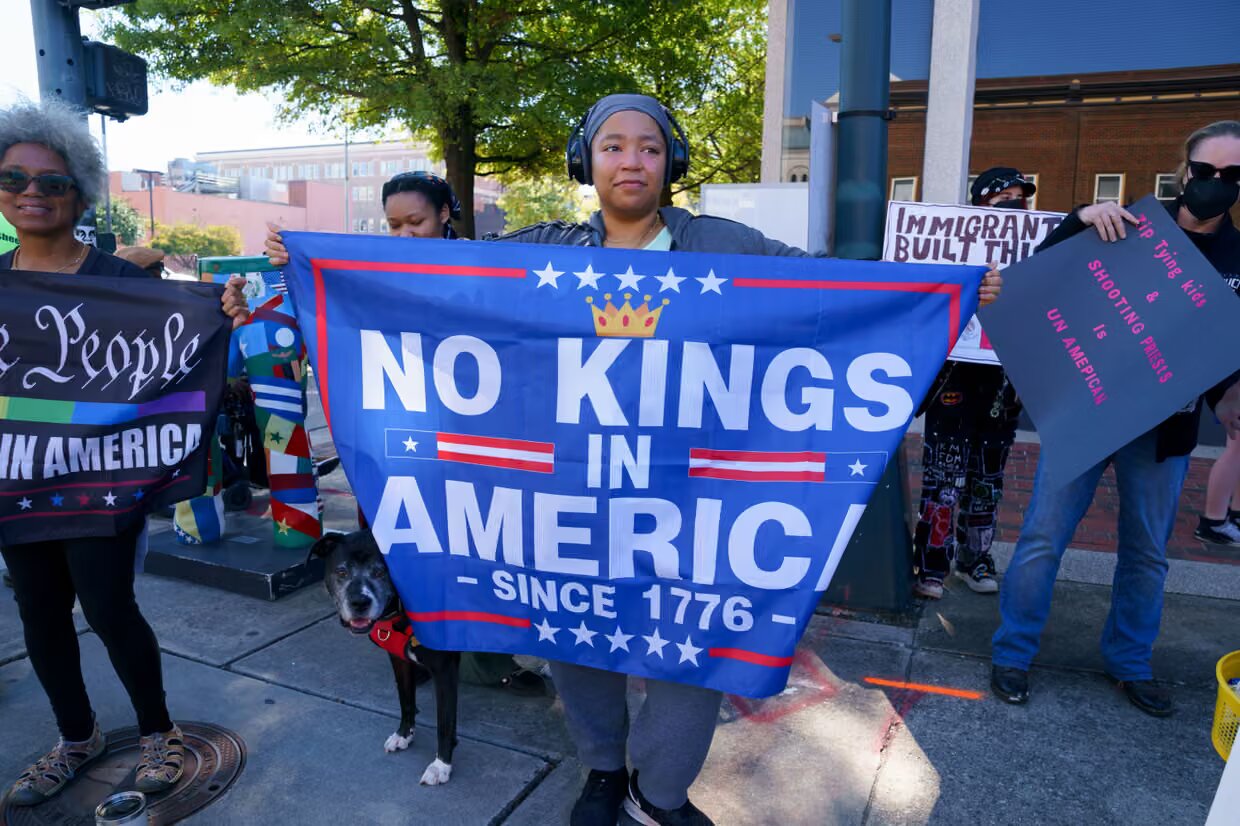Millions took to US streets to oppose authoritarianism as Democrats acknowledge ‘People want to see us fighting’

They marched in their millions. Some waved the Stars and Stripes. Some clutched signs with slogans such as: “Nothing is more patriotic than protesting.” And some donned inflatable costumes that included aliens, chickens, clowns, frogs, lobsters, mushrooms, penguins, seahorses, sharks, squirrels, starfish and unicorns.
The energy of last weekend’s No Kings protests against Donald Trump’s authoritarianism was palpable and peaceful, drawing an estimated 7 million people to 2,700 rallies across the country. Among them were the Democratic senators Cory Booker, Ed Markey, Chris Murphy, Adam Schiff, Chuck Schumer, Raphael Warnock and Elizabeth Warren as well as the independent Bernie Sanders.
But many Democratic lawmakers did not attend. Their absence was conspicuous at a time when the party stands accused of lacking fight and failing to meet the moment. As Trump runs riot through US democracy, Democrats face the challenge of harnessing the spirit of No Kings and turning anti-Trump sentiment into votes at the ballot box.
“We’re in the process of a fight to save our democracy,” said Murphy, a senator for Connecticut who spoke at the event in Washington. “As I said at the rally, we’re not on the verge of an authoritarian takeover; we’re in the middle of it. And what I know from history is that the only thing that saves democracies from ruin when a demagogue is trying to destroy it is mass mobilisation.”
For all his grandstanding, Trump is deeply unpopular. About 62% of Americans say the country is going in the wrong direction, according to a new survey by the Public Religion Research Institute and Brookings Institution, and 56% describe Trump as a “dangerous dictator whose power should be limited”.
The popular revolt against him appeared slow at first but is now gathering steam. There have been three major street protests organised by a broad coalition of dozens of groups including civil rights organisations, labour unions and pro-democracy movements such as Indivisible.
The first, known as Hands Off!, was held in April and drew 3 million people. The second, No Kings, was staged in June to coincide with Trump’s 79th birthday and a rare military parade in Washington, attracted 5 million people. Then came last weekend’s reprise of No Kings, whose turnout of 7 million people was said to be the biggest civic action in the US for more than half a century.

No Kings – which draws its name from America’s founding principles and resistance to the tyranny of Britain’s King George III – and the Democratic party are both essentially leaderless but the former’s momentum has thrown the latter’s inertia into sharp relief.
Trump’s victory in last year’s election came like a kick to the solar plexus. His shock and awe approach on taking office left Democrats divided and despondent. The party’s approval rating was at the lowest level for a generation. In March Chuck Schumer, the minority leader in the Senate, was berated for allowing a government funding bill to sail through the chamber without using it to challenge Trump.
Six months on, however, Schumer’s Democrats have refused to vote on legislation that would avoid a government shutdown as they demand funding for healthcare. Polls suggest they are winning the argument in the court of public opinion.
Democrats are fighting back in other ways. Gavin Newsom, the governor of California, is pushing a new electoral map in his state that aims to bolster his party’s chances of regaining a congressional majority in 2026 and counter Republican efforts to add more seats in Texas and other states. The effort has been endorsed by former president Barack Obama.
Newsom has also been at the forefront of some savage online humour mocking Trump. Governor JB Pritzker of Illinois has been similarly pugnacious. This week Senator Jeff Merkley delivered a 22-hour 37-minute speech on the Senate floor describing Trump’s authoritarianism as “the most perilous moment, the biggest threat to our republic since the civil war”.
Murphy has been one of the most prominent senators sounding an alarm for the future of US democracy. He told the Guardian: “We should pay attention to the fact that we were a pretty unpopular party before we took a stand on government funding and we’re a more popular party after having taken this stance.
“People do want to see us fighting. They do want to see us engaging in risk-tolerant behavior. They want us to use leverage when we have it and I hope my colleagues recognise that we won’t be able to beat Trump if people don’t see the Democratic party as an effective opposition party.”
Indivisible has been urging Democrats to show some spine. Ezra Levin, its co-founder, believes the party has gone through three phases of defiance since Trump returned to power. First there was condescending dismissal.
He said: “It was there will be no defiance, there will be no resistance, the grassroots is done and discredited and the smart move is to demonstrate how well we can work with Trump because that’s the future of the party. That was the dominant strategic vision of the Democratic party circa November, December, even January of this year.”
I think a memo went around Democratic circles to tell people to cuss more
Ezra Levin, Indivisible
According to Levin, however, once activists began showing up at town halls and took part in the Hands Off demonstration, Democrats were forced to recalibrate to a second phase, which he describes as performative resistance – the aesthetics of opposition.
“It was strongly worded letters. I think a memo went around Democratic circles to tell people to cuss more so there was more cursing. You saw fiery speeches but still a refusal to use leverage. It’s in this period that Schumer surrenders on the Republican bill and you see Cory Booker vote for the crypto bill after giving an inspiring speech.”
Now, Levin perceives a shaky third phase of unified defiance, exemplified by Democrats’ willingness to hold the line during the government shutdown. He hopes this resolve will feed into primary elections for next year’s midterms with candidates who are “fightback Democrats” rather than “do nothing Democrats”.
